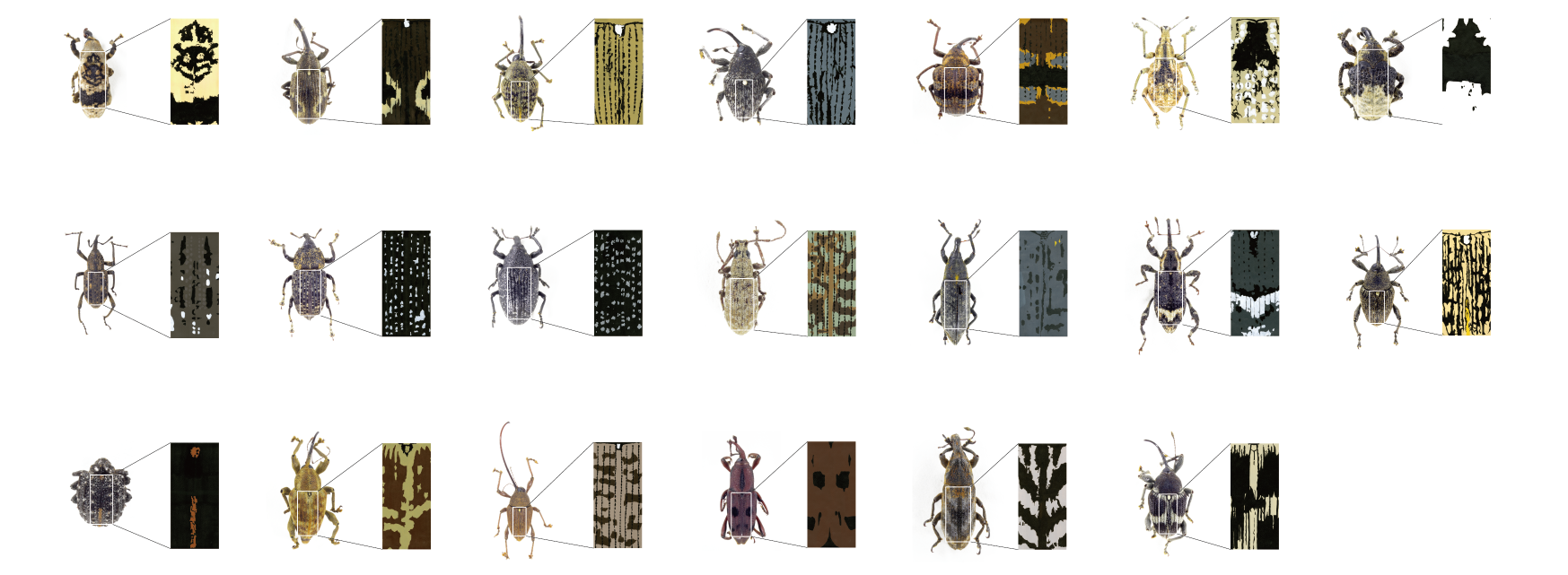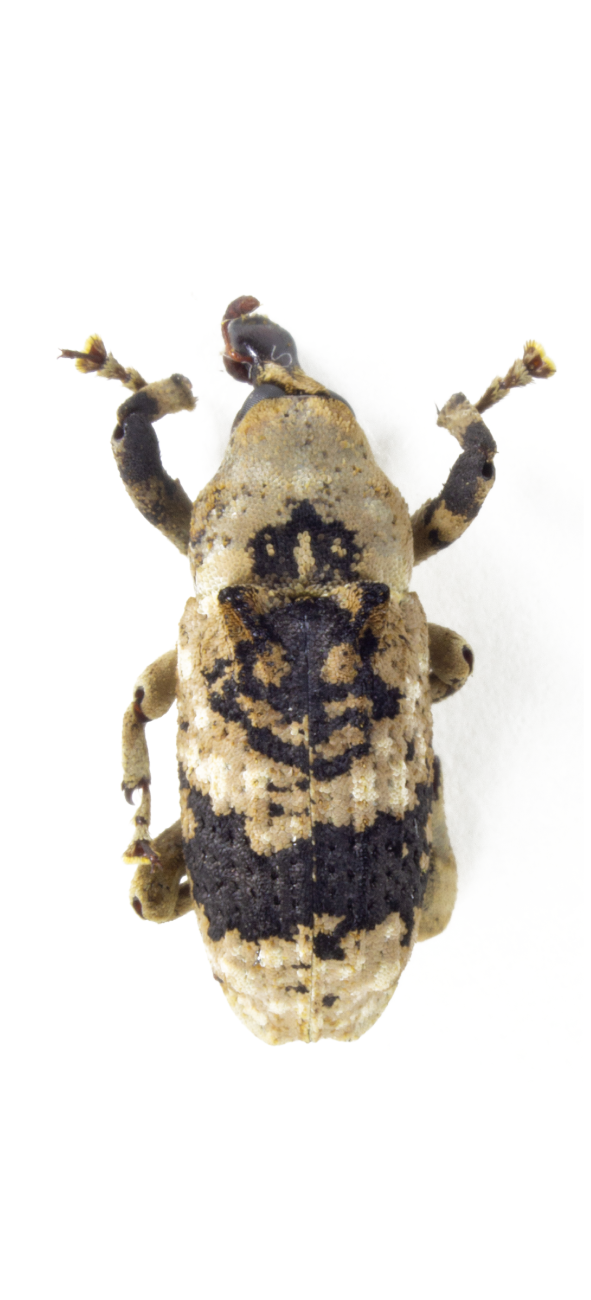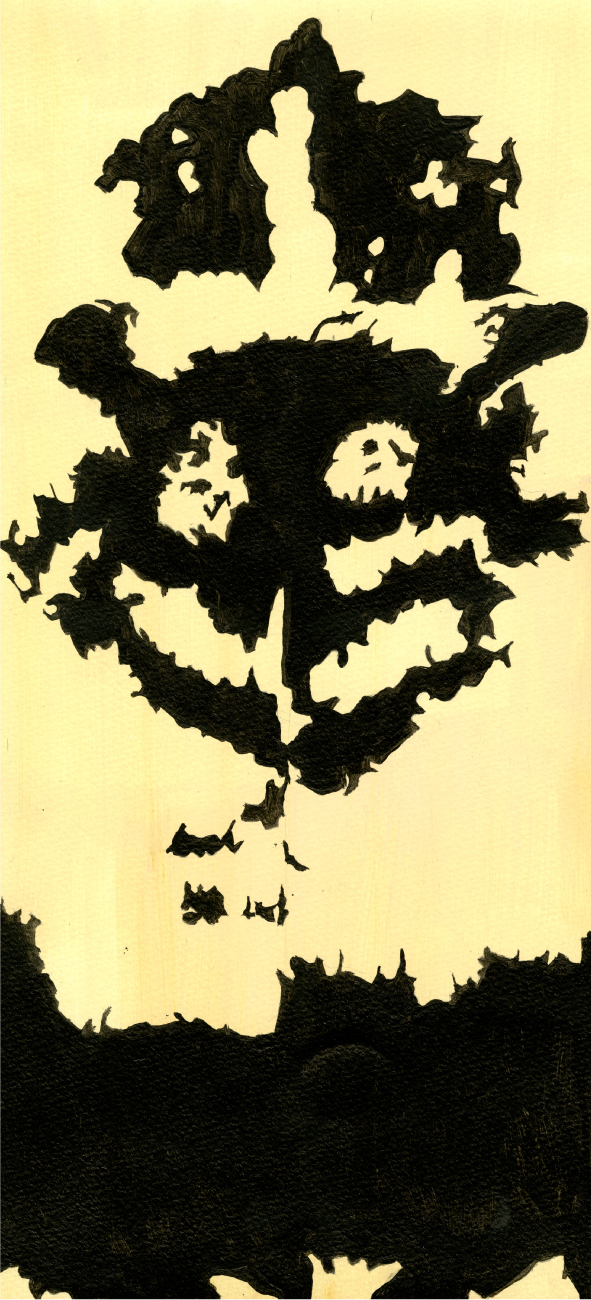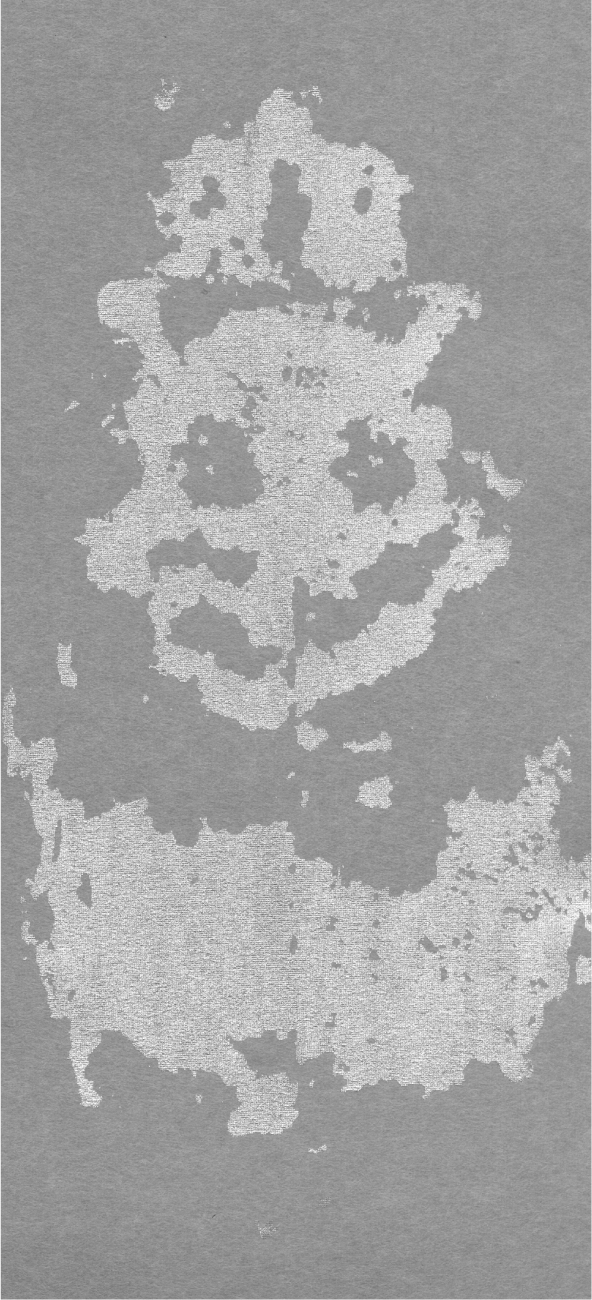東京象虫図案見本帖とは。
東京に生息する象虫20種類の柄から、模様を制作し、それを見本帖にまとめたものである。
1、テーマ
この作品を作るにあたってテーマが2点ある。1点目は「バイオミミクリー」という考え方である。これは1990年代にアメリカのJAMINE M BENYUS氏が提唱した、和訳すると「生物模倣」という考え方で、文字通り生物や自然界から知恵を借りて新しい技術やデザインを作り出すことである。この考え方をグラフィックデザインに応用できないかと考え、本制作を始めた。次に2点目は「ミクロなものを拡大して観る視点」である。本制作の土台として、ゾウムシ実物の柄を観察する際に肉眼で観察する際には観ることができない細かい柄をマクロレンズを通して観ることで新しい柄や見たこともない柄を発見できるのではないかと考え、この視点で観察を始めた。
2、観察
東京に生息するゾウムシ20種類の観察を行った。観察というが生態の観察ではなく上翅の柄の観察である。ゾウムシとは体長が3mmから20mm程度の小型の甲虫である。ゴツゴツした体と、長い象の鼻のような口が特徴である。その中でやはり上翅の模様が種類ごとに異なっており、その部分に注目し、一種類ごとに観察しスケッチをおこなった。実物の数十倍の大きさでスケッチを行うことによって、細かい柄の解像度をさらに上げて観察することができ、肉眼では到底観察できることのない自然界の柄を発見した。
3、模様の制作
観察で得られたゾウムシの柄や視点を応用して模様を制作した。模様の制作においてのポイントは3点ある。1点目は観察で得られたミクロなものを拡大して観る視点を用いることである。そのために。より繊細な柄を取り出すことを目的に写真でゾウムシの柄を撮影しそれを拡大して柄を読み込んだ。2点目は柄と共にゾウムシの特徴でもあるゴツゴツ感も平面として取り出すことである。そのためにゾウムシの柄の写真を色ごとにレイヤー分けすることで、陰影等も取り出すことができ、ゴツゴツ感を平面で取り出すことができた。3点目は色や素材感という要素を削ぎ落とし表現するということである。模様を制作する上で全体統一された表現とするために色やテクスチャの素材感(光沢やマット、毛並み等)の要素を排除し、全てをモノトーンの表現とした。
4、見本帖としてまとめる
3で制作した模様を見本帖としてまとめた。灰色の里紙にシルバーインク、雪色の里紙に白インク、白色の紙に黒インクの3種類の組み合わせを全20種類で合計60枚をシルクスクリーン印刷で制作。さらに、アクセントとして蛍光色や銀光沢紙等を用いたものを5枚制作した。これらを縦96mm、横216mm、厚さ23mm、糸がかり綴じの本としてまとめた。また、柄の見本帖と別で観察の際に行ったスケッチや、写真等を掲載した本も同サイズで制作を行った。

What is Tokyo Zomushi Design Sample Book?
I created patterns from the patterns of 20 types of elephant insects that inhabit Tokyo, and compiled them into a sample book.
1. Theme
There are two themes in making this work. The first is the concept of “biomimicry”. In the 1990s, Mr. JAMINE M BENYUS of the United States proposed this idea, which translates into Japanese as "bio-mimicry." It literally means borrowing wisdom from living things and the natural world to create new technologies and designs. I thought that I could apply this way of thinking to graphic design, and started this production. Next, the second point is "the perspective of magnifying the microscopic things". As a basis for this production, when observing the pattern of a real weevil, it is not possible to discover new patterns or patterns that have never been seen by looking at fine patterns that cannot be seen with the naked eye through a macro lens. I started observing from this point of view.
2. Observation
We observed 20 species of weevils living in Tokyo. Observation is not the observation of the ecology, but the observation of the stalk of the upper wing. Weevil is a small beetle with a body length of 3mm to 20mm. It is characterized by its rugged body and long elephant-trout-like mouth. Among them, the pattern of the upper wing is different for each species. By making sketches that are dozens of times larger than the real thing, I was able to observe finer patterns with higher resolution, and discovered patterns in the natural world that could never be observed with the naked eye.
3. Making patterns
I created patterns by applying patterns and perspectives of weevils obtained from observation. There are three points in the production of patterns. The first point is to use a perspective that magnifies and sees the microscopic things obtained by observation. for that. For the purpose of extracting a more delicate pattern, I photographed the pattern of the weevil, enlarged it, and read the pattern. The second point is to take out not only the pattern but also the ruggedness that is characteristic of weevils as a flat surface. For that reason, I was able to take out the shadows and the like by dividing the photo of the weevil pattern into layers for each color, and I was able to take out the ruggedness on the plane. The third point is to express by stripping off the elements such as color and texture. In order to create a unified expression for the pattern, we eliminated the elements of color and texture (glossy, matte, fur, etc.) and made everything monotone.
4. Summarize as a sample book
The pattern created in 3 is summarized as a sample book. A total of 60 sheets of 20 different combinations of silver ink on gray satogami, white ink on snowy satogami, and black ink on white paper were produced by silk screen printing. In addition, five pieces were produced using fluorescent colors and silver glossy paper as accents. These were put together as a book with a length of 96 mm, a width of 216 mm, and a thickness of 23 mm. In addition to the sample book of the pattern, I also produced a book in the same size that posted the sketches and photographs that I made during the observation.






